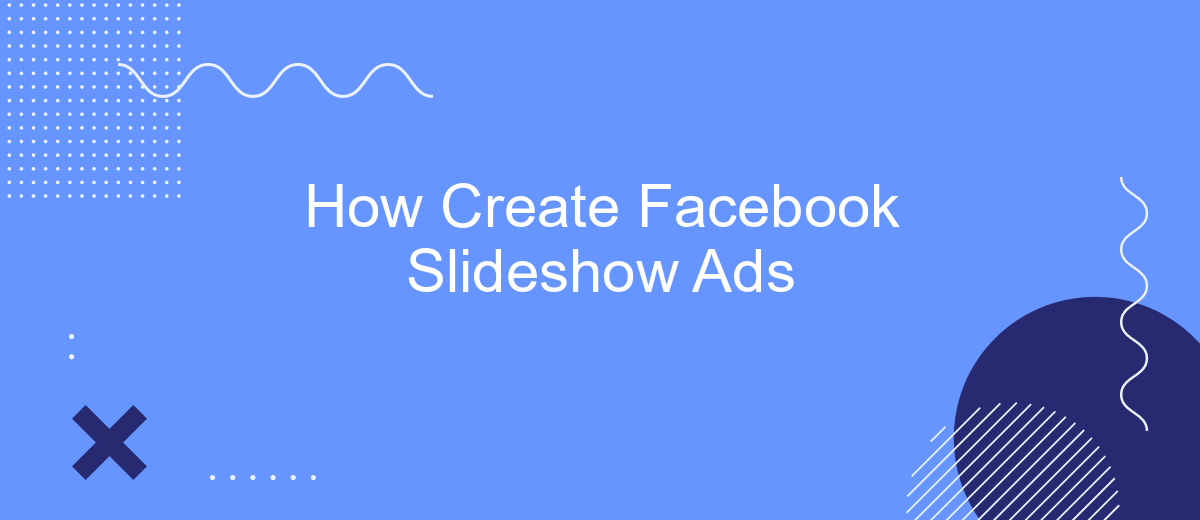Creating Facebook Slideshow Ads is an effective way to engage your audience with visually appealing content. These ads combine multiple images, text, and sound to deliver a compelling story that captures attention. In this article, we'll guide you through the steps to create captivating slideshow ads that can boost your marketing efforts and drive better results on Facebook.
Create Eye-Catching Visuals
Creating eye-catching visuals is crucial for the success of your Facebook slideshow ads. High-quality images and videos can significantly increase engagement and conversion rates. To make your visuals stand out, focus on clarity, relevance, and emotional appeal. Ensure that your visuals are consistent with your brand's identity and message.
- Use high-resolution images to maintain clarity and professionalism.
- Incorporate vibrant colors to capture attention quickly.
- Include text overlays to highlight key messages or offers.
- Utilize motion graphics to add dynamism and interest.
- Ensure all visuals are mobile-friendly and load quickly.
Remember, the goal is to create visuals that not only attract attention but also convey your message effectively. Test different combinations of images, colors, and text to see what resonates best with your audience. By investing time and effort into crafting compelling visuals, you can significantly boost the performance of your Facebook slideshow ads.
Craft Compelling Content

To craft compelling content for your Facebook slideshow ads, start by understanding your target audience. Research their preferences, pain points, and interests to tailor your message effectively. Use high-quality images and videos that resonate with them, ensuring they are visually appealing and relevant. Keep your text concise and impactful, emphasizing key benefits and unique selling points. Incorporate a strong call-to-action (CTA) to guide viewers on the next steps, whether it's visiting your website, signing up for a newsletter, or making a purchase.
Utilize storytelling techniques to make your content more engaging. Share customer testimonials, behind-the-scenes looks at your business, or success stories that highlight the value of your product or service. Consistency in branding is crucial, so use your brand colors, fonts, and logo to create a cohesive look. If you're integrating customer data or automating your ad campaigns, consider using services like SaveMyLeads. This tool can help streamline the process by connecting your Facebook ads with various CRM and marketing platforms, ensuring your leads are efficiently managed and followed up.
Decide on Audience and Goals

Before you start creating your Facebook slideshow ad, it's crucial to define your target audience and set clear goals. Knowing who you want to reach and what you aim to achieve will guide your ad creation process and help you measure its effectiveness.
- Identify your target audience: Consider demographics such as age, gender, location, and interests. Use Facebook's audience insights to refine your audience further.
- Set your campaign objectives: Decide whether you want to increase brand awareness, drive traffic to your website, generate leads, or boost sales. Your objective will influence the design and messaging of your ad.
- Determine your budget and schedule: Allocate a budget that aligns with your goals and decide on the duration of your campaign. Facebook allows you to set daily or lifetime budgets.
Having a well-defined audience and clear goals ensures that your Facebook slideshow ad is both relevant and effective. This preparation will help you create content that resonates with your audience and achieves your desired outcomes.
A/B Test for Optimal Results

A/B testing is a crucial step in optimizing your Facebook slideshow ads. By comparing two versions of an ad, you can identify which elements resonate most with your audience and drive better results. This method helps you make data-driven decisions, ensuring your marketing efforts are both effective and efficient.
To conduct an A/B test, start by creating two variations of your slideshow ad. These variations should differ in only one element, such as the headline, image sequence, or call-to-action. This allows you to pinpoint exactly what drives higher engagement or conversions.
- Test different headlines to see which catches more attention.
- Experiment with various image sequences to find the most compelling visual story.
- Compare different calls-to-action to determine which prompts more clicks.
After running your A/B test for a sufficient period, analyze the results to see which version performed better. Use these insights to refine your ads, continuously improving your campaigns based on what works best for your audience. Consistent testing and optimization are key to maximizing your advertising ROI.


Analyze and Refine
Once your Facebook slideshow ad is live, it's crucial to monitor its performance regularly. Utilize Facebook's Ads Manager to track key metrics such as engagement rates, click-through rates, and conversion rates. By analyzing these metrics, you can identify what's working and what needs improvement. For instance, if you notice a high engagement rate but a low conversion rate, it might be worth revisiting your call-to-action or landing page to ensure they align with your audience's expectations.
Refining your ad based on data-driven insights is essential for maximizing its effectiveness. Consider A/B testing different elements like images, headlines, and ad copy to see which combinations yield the best results. Additionally, integrating services like SaveMyLeads can streamline your lead management process by automatically transferring leads from your Facebook ads to your CRM or email marketing platform. This not only saves time but also ensures that no potential customer is overlooked, allowing you to focus on optimizing and scaling your ad campaigns.
FAQ
How do I create a Facebook Slideshow Ad?
What are the image requirements for a Facebook Slideshow Ad?
How many images can I use in a Facebook Slideshow Ad?
Can I add music to my Facebook Slideshow Ad?
How can I automate the creation and management of Facebook Slideshow Ads?
SaveMyLeads is a simple and effective service that will help you automate routine tasks and optimize business processes. Stop wasting time uploading leads from Facebook manually – you can do it automatically, saving a lot of time and money. Eliminate routine from workflows and achieve more with minimal investment of money, effort and human resources.
